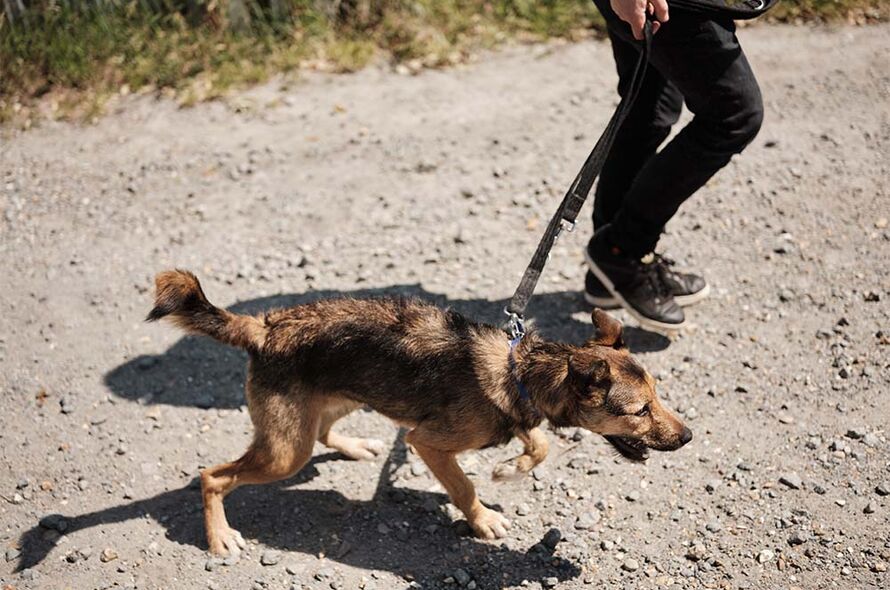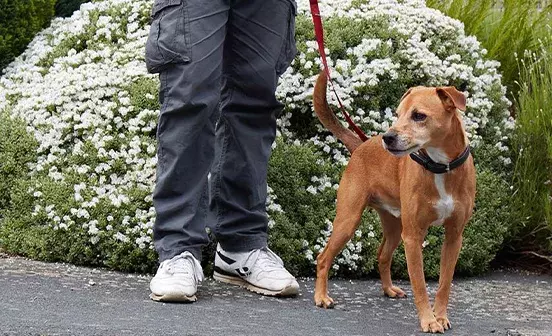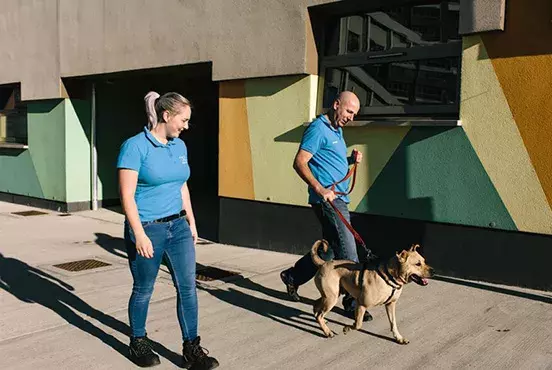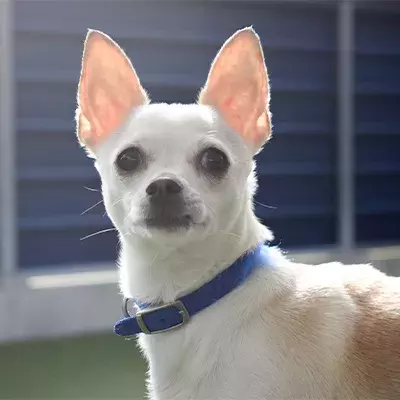Sometimes known as leash aggression, lead frustration is when your dog becomes agitated when put on a lead, or when they are feeling restricted.

The way you help your dog with this will depend on why your dog is frustrated, and what they are directing that frustration at. The most common triggers of lead frustration are often other dogs, or people.
We’ve put together some tips and tricks that you can work on to help your dog to feel more relaxed when out on a walk. These are designed for dogs who are social with other dogs and people when off lead but get frustrated because they can’t get to them when they are on lead. You might notice that they may become bouncy, or vocalise and that they pull on the lead to try to get to other dogs. If your dog normally walks on a collar and lead, you could also try walking them on a harness, or vice versa, as they may have built up certain associations with pressure being applied in the different areas.
If your dog is displaying extreme behaviour when on the lead, we would recommend speaking to a qualified behaviourist who will be able to help one-on-one with your dog and figure out what’s happening and why.
Useful behaviours to teach a dog when dealing with lead frustration
When teaching any new behaviour, your dog needs to be able to reliably perform the behaviour in an area with no distractions (such as your house or the garden) before you attempt to ask for that same behaviour in more challenging environments such as the street or the park.
In order to increase your dog’s focus and attention on you, keep your training sessions short. Try to ensure that your dog is successful by increasing the difficulty gradually in each session. Where possible, finish your session while your dog is still engaged in the training and enjoying themselves. Resist the urge to try one more time!
Watch
Teaching your dog a ’watch’ cue is a handy way to get your dog to look at you when you may be approaching something that may trigger their lead frustration. This will mean you and your dog, or the trigger itself can pass, move to a safe space, or change direction.
This way
Teaching a ‘this way’ will help with lead walking as it gives your dog the cue to change direction with you. Add the cue by saying “this way” and calmly changing direction as you are practicing your lead walking. Do this frequently to build your dog’s association between the command and the action.
Emergency ‘u’ turn
An emergency ‘u’ turn is a great skill to teach your dog to get you out of a situation where they are either likely to react or have started to react to something. Practice in a quiet location with few distractions first. With your dog on the lead, walking next to you, change direction suddenly (back the way you came from) and call them to you if necessary. Reward your dog when they turn with you. Keep practicing this, and once they’re comfortable with the action indoors, build up to practicing in slightly more distracting environments, like the garden or outdoor space, then a quiet area of the park, etc.
Loose lead walking
Teaching your dog to walk on a loose lead can also help when working on your dog being frustrated, or reactive on the lead. When walking, try to keep your dog engaged, and reward them for remaining on a loose lead by your side, but also ask for other behaviours that they know such as ‘sit’, ‘watch’ or ‘this way’ and reward them for this. Take a look at our advice on loose lead walking for more information.
Reward your dog with praise, toys or food if they look back or up at you at any point. The more you reinforce the behaviours that you like, the more likely it is that your dog will repeat these in the future. You can also practice an emergency ‘u’ turn cue randomly every now and again, even if your dog’s trigger isn’t present.
Try changing direction and changing pace of walking to see if your dog really understands loose lead walking before you increase the difficulty.
Things to do before you take your dog out on the lead
Avoid their triggers
While you’re still training your dog, as much as possible you want to try and avoid their triggers outside of sessions, so they don’t keep repeating the behaviours you’re trying to stop. You may need to walk them at quieter times or along different routes to make this more likely. As their training improves and they are focusing on you more when out for a walk, you can start to increase the level of distraction. Try not to be tempted to rush your dog through the different stages of training though. You want your dog to be successful and show positive behaviours as this gives you the chance to reward those behaviours. Being able to do this will mean your dog is more likely to repeat those positive behaviours in the future.
If you do see or come across one of your dog’s triggers when out, try to remain calm and practice the emergency ‘u’ turn. Reward your dog if they don’t react to the trigger. If they do react try to stay calm, move yourselves away or allow the other dog or person to pass, then take a couple of minutes to calm yourself and your dog down. Try to do some basic training before finishing the session on a good note.
Find their favourite rewards
It’s useful for all types of training to figure out if your dog prefers toys or food. Find out what your dog likes and will respond to by trying lots of different things. Practise toy exchange (where you swap one toy for another), play search games by hiding toys or treats for your dog to find, and practice other basic training in a relaxed, fun environment. Is their favourite a squeaky toy or a tennis ball? What food will your dog work for when there is lots going on? Do they prefer small pieces of sausage or perhaps cheese?
Once you have found out what your dog’s favourite thing is, save this for when you are out and about. Take that high value squeaky toy or some sausages for your dog and use it to reward your dog when they’re behaving calmly and appropriately for the situation.
You can also experiment with different ways to keep your dog engaged. You could let them chase a treat you have thrown or try using ‘jackpot rewards’ occasionally where you reward them with multiple treats for performing one amazing behaviour really well. Try mixing up a variety of treats so that you keep your dog guessing as to what reward will be available next, and remember if your dog finds verbal praise, attention or toys equally or more rewarding, you can use these as well.
Increasing difficulty
Before you head straight to the park, consider whether the park is the most appropriate place to walk your dog at the moment. Is this going to help with the training you have already implemented, or could it disrupt your progress? Some woodland or a quieter field could be a more appropriate location, somewhere where you can both have a stress-free walk without many people, or dogs, or other potential triggers. It might be that for now, road walks are most beneficial to you and your dog.
Getting your dog more comfortable around their frustration triggers
Other dogs
If your dog’s frustration is directed towards other dogs, try and find some friends who have well behaved, calm dogs to parallel walk with you. Explain to them before you set out what you are working on with your dog, choose a quiet location so they are the only ones around, at least to begin with, and then decide on a distance to walk apart from each other. If your dog is struggling, move further away and if your dog is doing well try to move a little closer.
If the fact that the other dog is moving is too much for your dog to cope with, try asking to keep the other dog still. Once you and your dog are able to calmly walk past a trigger that is still you can build up to having the trigger moving around.
Practice what you taught your dog at home and reward the behaviours you like with your dog’s favourite rewards. Remember the aim is to finish on a good note, keep the session short and try to avoid your dog reacting. If they do, move them away to a distance they can feel calm and try again. Finish the session when your dog is doing well, not once either of you have got frustrated. Eventually your dog will learn they need to remain calm and relaxed to meet other dogs.
If your dog is fine to meet other dogs off lead and just finds the build up frustrating it may be that you practice the parallel walking and then allow the two dogs to play off lead together in a safe place once your dog has calmed down, providing both dogs get along and both you and your friend are happy for the dogs to play together.
People
If your dog is frustrated when they can’t greet people, ask some friends who are comfortable with dogs to help you, perhaps somebody who already knows your dog. Follow the same steps as above, parallel walking to get your dog used to being around their trigger without immediately being able to reach them, but with a person instead.
If the fact that the person is moving is too much for your dog to cope with, try asking them to stand still. Once you and your dog are able to calmly walk past a trigger that is still you can build up to having the trigger moving around.
A dog who is leash reactive or frustrated on the lead can be very frustrating for us as owners too. Try to remain calm in these situations and don’t be tempted to punish your dog for reacting. Dogs learn by association, so when things happen together, they see them as cause and effect. For example, if your dog sees another dog and reacts and you shout at them and pull harshly on the lead there is a risk that they will associate those things with the presence of other dogs. They might start to fear other dogs coming towards them which is likely to result in them becoming aggressive towards other dogs.
Instead of trying to tell our dogs what we don’t want him to do, it is much easier, safer and more enjoyable for both you and them if you teach them what you do want instead. Rather than saying don’t bark or don’t pull, teach your dog to walk next to you and look up at you for a reward. Rather than saying don’t look at other dogs, teach them that if they stay calm and relaxed when around other dogs they’re either rewarded with a tasty treat, or some playtime with a toy, or even allowed to greet and play with the other dogs, but in a way that’s fun and positive for everyone involved.



